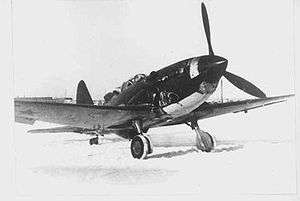Sukhoi Su-1
| Su-1/Su-3 | |
|---|---|
 | |
| Su-1 | |
| Role | High-altitude fighter |
| Manufacturer | Sukhoi |
| Designer | Pavel Sukhoi |
| First flight | 15 June 1940 |
| Status | Prototype |
| Primary user | Soviet Air Force |
| Number built | one Su-1, one Su-3 |
|
| |
The Sukhoi Su-1 or I-330 (Russian: Сухой Су-1) was a prototype Soviet high-altitude fighter aircraft built at the beginning of World War II. An improved version, designated Su-3 (I-360), was also built and tested the following year. Neither version was mass-produced.[1]
Development
In 1939, Sukhoi was tasked with designing a high-altitude fighter, the resulting Su-1 was a conventional monoplane with a streamlined wooden semi-monocoque fuselage, low-set all-metal wing made of duralumin and un-pressurized cockpit. The key feature of the aircraft was a pair of TK-2 turbochargers driven by exhaust gases from the Klimov M-105P engine.[2] The prototype was completed at the Sukhoi plant in Kharkov in May 1940, flying for the first time, on 15 June 1940, with A.P. Chernyavsky at the controls. Testing continued until 3 August, when Chernavskii mistakenly landed with the landing gear retracted. After the completion of repairs in mid-September, testing resumed, but an in-flight engine failure on 2 October resulted in a dead-stick landing. Limited flight testing continued until April 1941, with the Su-1 reaching a top speed of 641 km/h (345 kn, 400 mph) at 10,000 m (32,810 ft).[2] However, the turbochargers proved unreliable and without them the aircraft was inferior in performance to the Yakovlev Yak-1.[3]
Su-3
The second Su-1 prototype, built as the Su-3, differed in having a revised wing section with wing area reduced to 17 m² (183 ft²). Completed in 1941, the Su-3 demonstrated better performance than the Su-1, but suffered from continuing problems with the TK-2 turbochargers.[2] Further development was cancelled on 16 April 1941, when production of reliable TK-2 turbo-chargers was delayed.[1]
The fate of the two prototype aircraft is uncertain. According to some reports, the Su-1 was destroyed during the bombing of a train near Novosibirsk, while the Su-3 was destroyed within the city of Novosibirsk during the Great Patriotic War.
Operators
Specifications (Su-1)
General characteristics
- Crew: 1
- Length: 8.42 m (27 ft 8 in)
- Wingspan: 11.50 m (37 ft 9 in)
- Height: 2.71 m (8 ft 11 in)
- Wing area: 19 m² (205 ft²)
- Empty weight: 2495 kg (5,500 lb)
- Loaded weight: 2875 kg (6,340 lb)
- Powerplant: 1 × Klimov M-105P liquid-cooled twin-turbocharged V12 engine, 820 kW (1,100 hp)
Performance
- Maximum speed: 640 km/h (345 kn, 400 mph) at 10,000 m (32,810 ft)
- Range: 720 km (390 nmi, 445 mi)
- Service ceiling: 12,500 m (41,010 ft)
- Rate of climb: 10.33 min to 10,000 m (32,810 ft)
Armament
- 1 × 20 mm (0.79 in) ShVAK cannon
- 2 × 7.62 mm (0.30 in) ShKAS machine guns
See also
- Aircraft of comparable role, configuration and era
References
Notes
- 1 2 Antonov,Vladimir & Gordon, Yefim & others. OKB Sukhoi”. Leicester. Midland. 1996. ISBN 1-85780-012-5
- 1 2 3 4 Shavrov V.B. (1994). Istoriia konstruktskii samoletov v SSSR, 1938-1950 gg. (3 izd.). Mashinostroenie. ISBN 5-217-00477-0.
- ↑ "Sukhoi Su-1, 3". Sukhoi Company Museum. Retrieved 2007-01-14.
- ↑ Green, W; Swanborough, G (2001). The Great Book of Fighters. MBI Publishing. ISBN 0-7603-1194-3.
- Green, W; Swanborough, G (2001). The Great Book of Fighters. MBI Publishing. ISBN 0-7603-1194-3.
- Green, W; Swanborough, G (2001). The Great Book of Fighters. MBI Publishing. ISBN 0-7603-1194-3.
- Antonov,Vladimir & Gordon, Yefim & others. OKB Sukhoi”. Leicester. Midland. 1996. ISBN 1-85780-012-5
External links
| Wikimedia Commons has media related to Sukhoi Su-1. |
- "Sukhoi Su-1, 3". Sukhoi Company Museum. Retrieved 2011-07-12.